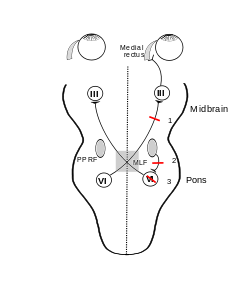One and a half syndrome

The one and a half syndrome is a rare weakness in eye movement affecting both eyes, in which one cannot move laterally at all, and the other can move in only one lateral direction (inward or outward). More formally, it is characterized by "a conjugate horizontal gaze palsy in one direction and an internuclear ophthalmoplegia in the other".[1] The most common manifestation of this unusual syndrome is limitation of horizontal eye movement to abduction (moving away from the midline) of one eye (e.g. right eye in the diagram on the right) with no horizontal movement of the other eye (e.g. left eye in the diagram on the right).[2] Nystagmus is also present when the eye on the opposite side of the lesion is abducted. Convergence is classically spared as cranial nerve III (oculomotor nerve) and its nucleus is spared bilaterally.
Anatomy

The syndrome usually results from single unilateral lesion of the paramedian pontine reticular formation and the ipsilateral medial longitudinal fasciculus. An alternative anatomical cause is a lesion of the abducens nucleus (VI) on one side (resulting in a failure of abduction of the ipsilateral eye and adduction of the contralateral eye = conjugate gaze palsy towards affected side), with interruption of the ipsilateral medial longitudinal fasciculus after it has crossed the midline from its site of origin in the contralateral abducens (VI) nucleus (resulting in a failure of adduction of the ipsilateral eye).
Causes
Causes of the one and a half syndrome include pontine hemorrhage, ischemia, tumors, infective mass lesions such as tuberculomas, and demyelinating conditions like multiple sclerosis.
Treatment
There have been cases of improvement in extra-ocular movement with botulinum toxin injection.[3][4]
See also
References
- ↑ Wall M, Wray S (1983). "The one-and-a-half syndrome--a unilateral disorder of the pontine tegmentum: a study of 20 cases and review of the literature.". Neurology. 33 (8): 971–80. doi:10.1212/wnl.33.8.971. PMID 6683820.
- ↑ Siegel A, Sapru HN (2006). Essential Neuroscience (1st ed.). Baltimore, Maryland: Lippincott, Williams, & Wilkins. pp. 190–191. ISBN 978-0-7817-9121-2.
- ↑ Kipioti A, Taylor R (2003). "Botulinum toxin treatment of "one and a half syndrome"" (PDF). Br J Ophthalmol. 87 (7): 918–9. doi:10.1136/bjo.87.7.918-a. PMC 1771745
 . PMID 12812899.
. PMID 12812899. - ↑ "Botulinum toxin injections". www.aesthetika.co.uk. Retrieved 30 August 2015.
External links
- 1060438082 at GPnotebook - This link incorrectly states that the contralateral eye can still adduct. It can only abduct with nystagmus.
- Video at University of Utah